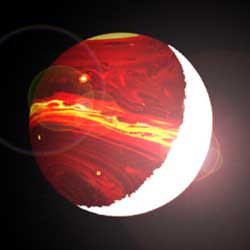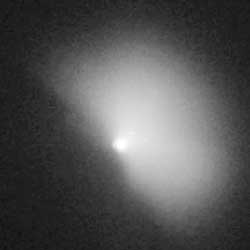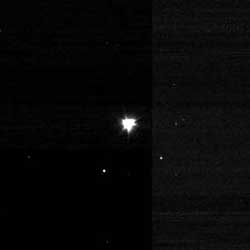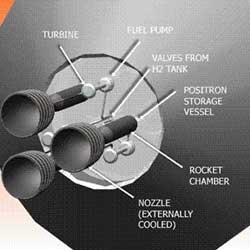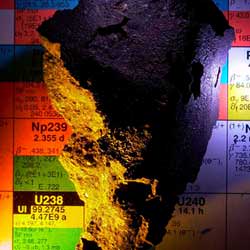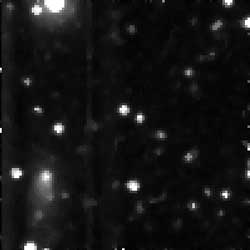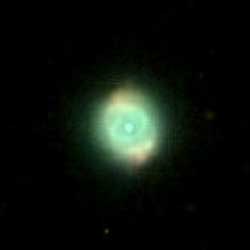
The “Cat’s Eye” Nebula. Image credit: Chris Deforeit at Astrim. Click to enlarge.
Monday, July 4 – 1054 A.D. This is the suspected date when Chinese astronomers noted the supernova from which we know the remnants of today as M1, the “Crab Nebula”. While this incredible event marks a red letter day in astronomy history, another is in the making.
If everything goes successfully, Deep Impact will have already been released and the information pouring in. For most of us, tonight will be our first chance to view, but for the lucky astronomers in the extreme western Americas – you’ve beat us to it! Just 3.5 degrees east/northeast of Spica, the comet is speculated to rise to 6th magnitude as the debris cloud spreads. No one knows exactly how long this will last, but viewers around the globe will get their opportunity to witness this event with a backyard telescope over the next 24 hours. Be there! I wish you all the very best of skies for this event.
So, if we can’t see a supernova remnant like the M1, or watch explosion happen on a comet, then what else can we do tonight? I’ve got a great idea – let’s check out the “Cat’s Eye” – it’s the best of both worlds! The proper designation is NGC 6543 and it’s located about midway between Delta and Zeta Draconis. As one of the most complex of all the planetary nebulae, it rose to popularity with the awesome Hubble photo. Very similar to the “Helix” nebula, our blue-green friend is the ejecta of a dying (possible double) star. This colorful planetary sends its light to us from roughly 3200 light years away and was the very first to be studied spectroscopically.
At magnitude 8.8, the “Cat’s Eye” can be spotted in large binoculars but will appear almost stellar. Smaller telescopes at high power will make it out as a slight disc, while larger scopes reveal the central star and far more color. For those with a nebular filter and a large scope, the NGC 6543 is a real pleasure to study as the helical area takes on form. Enjoy!
Tuesday, July 5 – Today as the date changes, the Earth reaches aphelion its farthest point from the Sun for the year while – oddly enough – Comet 9/P Tempel 1 reaches perihelion. So where’s the comet?
For northern hemisphere binocular users, look for the point of light visible to the southwest at twilight. That’s Jupiter. As the sky darkens completely, bright Spica will appear to Jupiter’s southeast. By aiming your binoculars there and placing Spica to the right of the field of view, you should be able to spot a faint fuzzy – the comet! For telescope users, Tempel 1 will appear almost directly between both star 68 and Gamma Virginis. Although we cannot perfectly predict what will happen after Deep Impact, studies suggest the comet will brighten to around 6th magnitude. Even if it doesn’t seem particularly impressive to smaller equipment, remember… You are viewing history! This will be the first time mankind has ever been able to make an effect on an astronomical object that can be viewed by the amateur.
If skies are cloudy tonight, keep trying. The effect of Deep Impact may last for days – or even weeks. The comet will continue to move south slowly over the next two weeks when it will be just west of Gamma Virginis.
Wednesday, July 6 – With some help from Edmond Halley, today in 1687 Sir Isaac Newton published his Principia with his three laws of motion. Since New Moon occurred in the early morning hours, this means dark skies tonight and an opportunity to study.
Normally, we’d go galaxy hunting on a dark night such as this, but how about if we explore the wonderful world of low power? Start by locating the magnificent M13 and move about 3 degrees northwest. What you will find is a splendid loose open cluster of stars known as Dolidze/Dzimselejsvili (DoDz) 5 – and it looks much like a miniature of the constellation of Hercules. Just slightly more than 4 degrees to its east and just about a degree south of Eta Hercules is DoDz 6, which contains a perfect diamond pattern and an asterism of brighter stars which resembles the constellation of Saggitta.
Now we’re going to move across the constellation of Hercules towards Lyra. East of the “keystone” you will see a tight configuration of three stars – Omicron, Nu and Xi. About the same distance that separates these stars to the northeast you will find DoDz 9. Using minimal magnification, you’ll see a pretty open cluster of around two dozen mixed magnitude stars that are quite attractive. Now look again at the “keystone” and identify Lambda and Delta to its south. About midway between them and slightly to the southeast you will discover the stellar field of DoDz 8. The last is easy – all you need to do is know beautiful red/green double, Ras Algethi (Alpha). Move about 1 degree to the northwest to discover the star-studded open cluster – DoDz 7. These great open clusters are very much off the beaten path and will add a new dimension to your large binocular, or low power telescoping experiences.
Thursday, July 7 – Are you ready for a visual challenge? Then see if you can spot the ultra-slim crescent of the Moon tonight. Less than a fist’s width above the horizon, look about 45 minutes after sunset as Selene begins its showing with the planets.
Tonight let’s try two more open star cluster studies that can be done easily with large binoculars or a low power scope. The first is a rich beauty that lays in the constellation of Vulpecula, but is easier found by moving around 3 degrees southeast of Beta Cygni. Known as Stock 1, this stellar swarm contains around 50 or so members of varying magnitudes that you will return to often. The next is an asterism known as the “Coat Hanger”, but it is also known as Brocchi’s Cluster, or Collinder 399. Let the colorful double star – Albeiro (which can be split in binos) – be your guide as you move about 4 degrees to its south/southwest. You will know this cluster when you see it, because it really does look like a coat hanger! Enjoy its red stars.
Friday, July 8 – What a way to start the weekend! As the skies darken to twilight tonight, be sure to check out the western horizon as the tender Moon has risen above our planetary pair of Venus and Mercury. Loaded with “earthshine”, this should be a picture perfect evening.
If skies are clear, let’s try some open star clusters in Cygnus. Starting with Gamma, identify loose open involving Gamma named Dolidze (Do) 43. Move two degrees southwest and pick up Do 42. Do not confuse it with nearby M29 – for the two look very similar. For fans of the “Double Cluster” in Perseus, you’ll like the next as we move another half degree to the southwest along the body of Cygnus to discover Do 40 and Do 41. This pretty pair of open clusters can be placed in the same lower power field. By moving another half degree due west, you’ll find highly populated Do 39 and it is a double treat as well – the brighter clump of stars in the same low power field is IC 4996.
Saturday, July 9 – Tonight the Moon will be less than half a fist’s width away from the “heart of Leo”, Regulus. While you may need binoculars to spot the star, be sure to note both it and Venus’ position and watch over the next two weeks as they draw closer.
Tonight after the Moon sets, take out your binoculars again to view two bright open clusters. The first, Ruprecht 173 is about a degree northwest of Epsilon Cygnii. You’ll appreciate this heavily populated star cluster! The next is as easy as identifying the constellation of Lyra. Just southeast of bright Vega is a wonderful double for binoculars, Delta 1 and 2 – the easternmost of the top two stars in the lyre. This bright pair is part of an open cluster known as Stephenson 1.
Sunday, July 10 – Tonight let’s enjoy a quiet evening of lunar contemplation. A wonderful crater to watch over the coming days lay on the western edge of Mare Crisium – Proculus. Tonight you will see it as a bright ring, but it will soon develop a ray system as the terminator moves west. Another beautiful pair of craters are near the terminator in the northern quandrant of the lunar orb – Atlas and Hercules. They are a splendid sight in binoculars and scope users can easily spot interior craterlets in these old giants.
Even if you only follow Deep Impact virtually, please watch this spectacular event. We’ll be on hand for history! May all your journeys be at Light Speed… ~Tammy Plotner
